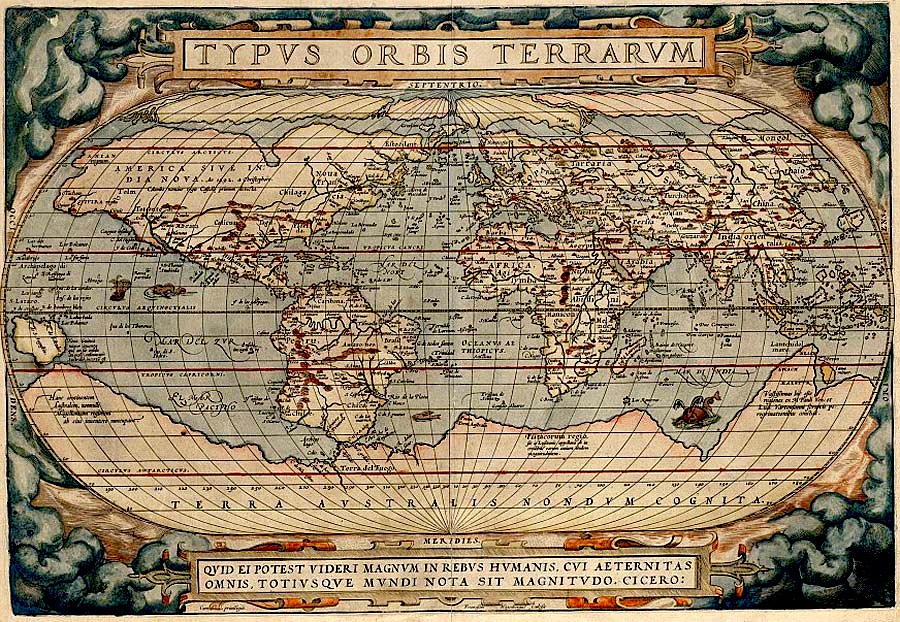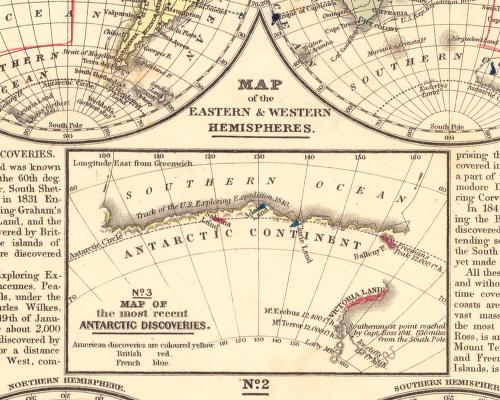This entry is part 1 of 4 in the series The Shackleton Expedition Theme Week+

Antarctica’s Heroic Age
During the Age of Exploration, which occurred roughly between the 15th and 18th centuries, humans believed a gargantuan continent covered most of the Southern Hemisphere. This landmass was known commonly as Terra Australis, Latin for “Southern Land.”
The impetus for this notion did not arrive thanks to direct evidence of a massive continent. Instead, it rested on the prevalent idea of “balanced land.” We figured the land in the Northern Hemisphere should be “balanced” by the same amount in the southern half of the planet, sort of like the Dark Matter of the unknown world. The remote, brutally unforgiving nature of the Southern Hemisphere allowed this idea to persist for hundreds of years.
James Cook’s second voyage, a circumnavigation of the southern portions of the planet from 1772-1775, shattered the notion of Terra Australis. He was able to circle the globe without knocking into a super-continent. Cook’s trek did, however, encounter incredible ice floes that prevented him from reaching what we now know as Antarctica. Cook dispelled the concept of a hemisphere-sized continent, but he did believe the prominence of ice required a large tract to produce it. He figured Antarctica was out there, he just couldn’t get to it.

Even if Cook’s supposed land existed, most people felt it would be too isolated and too inhospitable to matter economically. For decades, the thought of exploring the area disappeared.
Between 1819 and 1843, however, a smattering of voyagers attempted to probe Antarctica. In 1820, a Russian expedition led by Fabian Bellingshausen and Mikhail Lazarev became the first humans to sight Antarctica. By 1840, explorers had learned enough to remain near the landmass for periods long enough to chart the coasts.
Several expeditions claimed to have landed on Antarctica during this preceding stretch. However, the first confirmed landing on the continent did not transpire until 1895, when a Norwegian whaling boat docked on the continent-proper. After this point, the interest in exploring one of the planet’s last horizons exploded.

Historians now call the range of 1897 to roughly the time of World War I the Heroic Age of Antarctic Exploration.
The period afterward is often referred to as the Mechanical Era, which points to one aspect of the definition of the Heroic Age: the lack of gadgetry. As one might expect, the exploration of Antarctica is harrowing and perilous. The prospect of examining this area with the technology of the 21st century is daunting enough. The intrepid humans who sought to probe Antarctica during the Heroic Age were essentially on their own. This sort of low-tech mission required individuals who ranged somewhere between courageous and daredevils.
Most of the people who attempted expeditions during this period looked something like this:

Even the dogs look hardcore.
Nations from around the world sent teams to Antarctica during the Heroic Age, including Belgium, the United Kingdom, Germany, Sweden, France, Japan, Norway, Australia, and New Zealand.
While the previous era mainly sought to prove a continent existed, map its coasts, and make landfall, the expeditions of the Heroic Age sought to thoroughly investigate Antarctica. They wanted to navigate to the geographic and magnetic south poles; they wanted to traverse the entire continent. These voyages were extreme undertakings, which, of course, produced extreme results, good and bad.
Belgian Adrien de Gerlache kicked off the Heroic Age when his team became the first people to overwinter in the Antarctic Circle in 1898. A British crew then spent the entire winter on the mainland for the first time in 1899. Between 1901 and 1904, another British squad discovered the polar plateau that dominates Antarctica and climbed the Western Mountains. This group was led by one of the three dominant figures of the Heroic Age, Robert Falcon Scott (great name!).
For the next decade, dozens of ships full of crazy, brave people surveyed Antarctica, including a wonderfully named French ship: Pourquoi-Pas? IV This name means “Why Not?”

By 1911, serious pushes for the South Pole began.
The first mate of Adrien de Gerlache’s initial journey during the Heroic Age was the second major individual in the era: Roald Amundsen (great name!). He had graduated to expedition leader by the second decade of the 20th century and turned his eye to the big prize. Amundsen and Scott both attempted to find the South Pole concurrently. The geographic spot just happens to be near the center of the continent, so the journey was immensely dangerous.
Amundsen’s party arrived at the bottom of the planet on 14 December 1911. 33 days later, Robert Falcon Scott’s crew achieved the same feat. Unfortunately, every member of Scott’s team died on the way out.
One of the world’s last great exploratory challenges had been conquered.

One might conjecture with the pole in the bag that zeal for Antarctic exploration might wane.
The third prominent actor in the Heroic Age disagreed with that sentiment. Upon hearing Amundsen had reached the South Pole, Ernest Shackleton (great name!) responded, “The discovery of the South Pole will not be the end of Antarctic exploration.” Shackleton had served under Robert Falcon Scott in the era’s early days but had ascended to lead excursions. Between 1907 and 1909, Shackleton’s Nimrod Expedition had blazed the way for Amundsen and Scott’s South Pole pushes. Shackleton had reached the farthest south anyone had yet been, about 100 miles from the pole. With winning the pole race off the table, Shackleton turned to a more extreme idea.
Ernest Shackleton wanted to cross the entirety of Antarctica, from sea to sea. This final frontier would be the gnarliest journey and would put a stamp on the Heroic Age of Antarctic Exploration.

In 1914, Shackleton sailed on the Endurance for Antarctica.
His aim was the gnarliest journey across Antarctica. What he did not know then was his trek would enter the annals of history for an even gnarlier reason, one at which we still marvel to this day.
[To be continued…]Further Reading and Exploration
James Cook’s Second Voyage – Princeton University
Terra Australis – Princeton University
South Pole – National Geographic Society
The Heroic Age of Antarctic Exploration – Cool Antarctica
Reaching the South Pole During the Heroic Age of Exploration – Library of Congress
To the Ends of the Earth: The Heroic Age of Polar Exploration – Scientific American
- Antarctica’s Heroic Age
- Fortitudine Vincimus
- Third Man Factor
- Endurance














Pingback: Fortitudine Vincimus – themountainsarecalling.earth
Pingback: Endurance – themountainsarecalling.earth